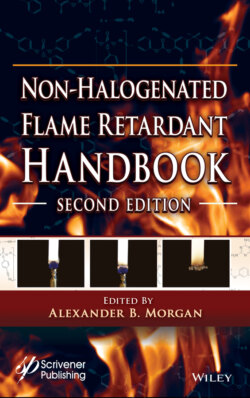Читать книгу Non-halogenated Flame Retardant Handbook - Группа авторов - Страница 2
Table of Contents
Оглавление1 Cover
2 Title
3 Copyright
4 Preface to the 2nd Edition of the Non-Halogenated Flame Retardant Handbook
5 1 Regulations and Other Developments/Trends/Initiatives Driving Non-Halogenated Flame Retardant Use 1.1 Regulatory History of Halogenated vs. Non-Halogenated Flame Retardants 1.2 Regulations of Fire Safety and Flame Retardant Chemicals 1.3 Current Regulations 1.4 Fire Safety and Non-Fire Safety Issues Requiring Non-Halogenated Flame Retardants 1.5 Regulatory Outlook and Future Market Drivers References
6 2 Phosphorus-Based Flame Retardants 2.1 Introduction 2.2 Main Classes of Phosphorus-Based Flame Retardants 2.3 Red Phosphorus 2.4 Ammonium and Amine Phosphates 2.5 Metal Hypophosphites, Phosphites and Dialkyl Phosphinates 2.6 Aliphatic Phosphates and Phosphonates 2.7 Aromatic Phosphates and Phosphonates 2.8 Aromatic Phosphinates 2.9 Phosphine Oxides 2.10 Phosphazenes 2.11 Environmental Fate and Exposure to Organophosphorus FRs 2.12 Conclusions and Further Trends References
7 3 Mineral Filler Flame Retardants 3.1 Introduction 3.2 Industrial Importance of Mineral Flame Retardants 3.3 Overview of Mineral Filler FRs 3.4 Working Principle of Hydrated Mineral Flame Retardants 3.5 Thermoplastic and Elastomeric Applications 3.6 Reactive Resins/Thermoset Applications 3.7 Conclusion, Trends and Challenges References
8 4 Intumescence-Based Flame Retardant 4.1 Introduction 4.2 Fundamentals of Intumescence 4.3 Intumescence on the Market 4.4 Reaction to Fire of Intumescent Materials 4.5 Resistance to Fire of Intumescent Materials 4.6 Conclusion and Future Trends References
9 5 Nitrogen-Based Flame Retardants 5.1 Introduction 5.2 Main Types of Nitrogen-Based Flame Retardants 5.3 Ammonia-Based Flame Retardants 5.4 Melamine-Based Flame Retardants 5.5 Nitrogen-Based Radical Generators 5.6 Phosphazenes, Phospham and Phosphoroxynitride 5.7 Cyanuric-Acid Based Flame Retardants 5.8 Summary and Conclusion References
10 6 Silicon-Based Flame Retardants 6.1 Introduction 6.2 Basics of Silicon Chemistry 6.3 Industrial Applications of Silicones 6.4 Silicon-Based Materials as Flame Retardant Materials 6.5 Mode of Actions of Silicone-Based Flame Retardants and Practical Use Considerations 6.6 Future Trends in Silicon-Based Flame Retardants 6.7 Summary and Conclusions References
11 7 Boron-Based Flame Retardants in Non-Halogen Based Polymers 7.1 Introduction 7.2 Major Functions of Borates in Flame Retardancy 7.3 Major Commercial Boron-Based Flame Retardants and Their Applications 7.4 Properties and Applications of Boron-Base Flame Retardants 7.5 Mode of Actions of Boron-Based Flame Retardants 7.6 Conclusions References
12 8 Non-Halogenated Conformal Flame Retardant Coatings List of Acronyms 8.1 Introduction to Conformal Coatings: The Role of Surface During Combustion 8.2 Fabrics 8.3 Porous Materials 8.4 Other Substrates 8.5 Future Trends and Needs References
13 9 Multicomponent Flame Retardants 9.1 The Need for Multicomponent Flame Retardants 9.2 Concepts 9.3 Combination with Fillers 9.4 Adjuvants 9.5 Synergists 9.6 Combinations of Different Flame Retardants 9.7 Combinations of Different Flame-Retardant Groups in One Flame Retardant 9.8 Conclusion References
14 10 Other Non-Halogenated Flame Retardants and Future Fire Protection Concepts & Needs 10.1 The Periodic Table of Flame Retardants 10.2 Transition Metal Flame Retardants 10.3 Sulfur-Based Flame Retardants 10.4 Carbon-Based Flame Retardants 10.5 Bio-Based Materials 10.6 Tin-Based Flame Retardants 10.7 Polymer Nanocomposites 10.8 Engineering Non-Hal FR Solutions 10.9 Future Directions References
15 Index
16 End User License Agreement
